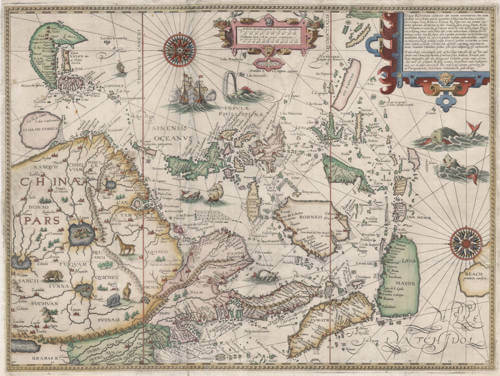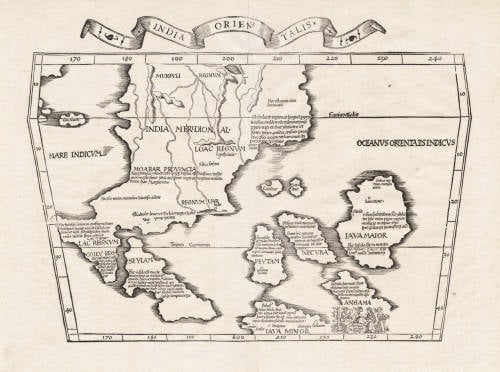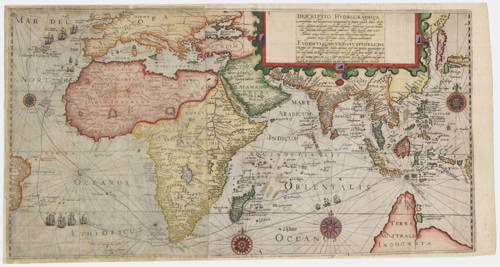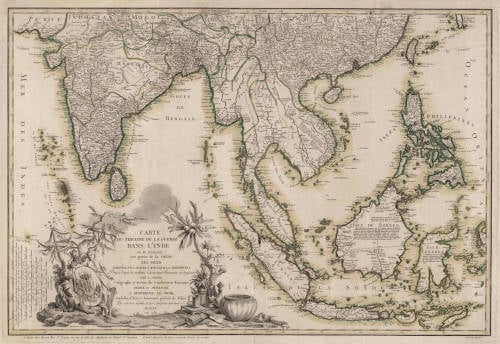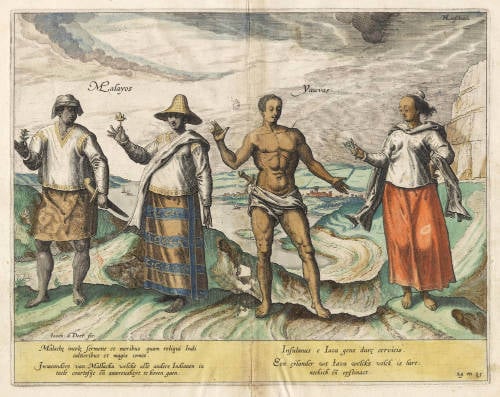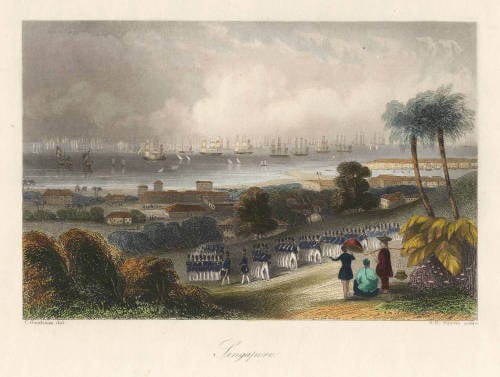Leen Helmink Antique Maps
the finest book on ethnography, topography, geography and scenery of Indonesia
Stock number: 19709
Zoom ImageCartographer(s)
Coenraad Temminck (biography)
Title
Verhandelingen over de natuurlijke geschiedenis der Nederlandsche overzeesche bezittingen door de Leden der Natuurkundige Commissie in Indië en andere schrijvers.
First Published
Leiden, 1839
This Edition
1839-1847
Size
Folio (42.6 x 29.1 cm) cms
Technique
Condition
excellent
Price
$ 12,500.00
(Convert price to other currencies)
Description
* the finest book on ethnography, topography, geography and scenery of Indonesia
* only 250 copies printed
TEMMINCK, Coenraad Jacob; Salomon MÜLLER Verhandelingen over de natuurlijke geschiedenis der Nederlandsche overzeesche bezittingen door de Leden der Natuurkundige Commissie in Indië en andere schrijvers; uitgegeven ... door C. J. Temminck. In commissie bij. S. en J. Luchtmans en C.C. van der Hoek, Leiden 1839-1844 [but 1839-1847] [41882]
First edition in book form. Folio. 86 plates on 85 sheets (1 double-page), some showing 2 subjects, including 19 hand-coloured lithographs, plus 5 unnumbered maps (1 double-page).
By far the most extensive and detailed work on the rich and diverse ethnography of the former Dutch East Indies (now Indonesia). Edited by the Dutch ornithologist Coenraad Jacob Temminck (1778-1858), this is largely the work of the German - later Dutch - zoologist Salomon Müller (1804-1863), who was employed by the Zoological Museum of Leiden.
The first volume of an important illustrated work on Indonesia, this one dealing with the ethnography, ethnology, scenery, topography and geography.
Bastin & Brommer pp14-17, n.265; Landwehr SDBCP 454; Colas 2158; Lipperheide 1492.
Rarity
Only 250 copies were printed. Lacking in nearly all collections.
Significance
The first volume of a very rare and important illustrated work on Indonesia, this one dealing with the scenery and people. Subsequent volumes were issued on the fauna and flora of Indonesia. “what must rank, not least for variety of subject matter, as one of the finest nineteenth century illustrated books on Indonesia. This monumental folio work is concerned with the investigations by members of the Natural Sciences Commission which had been established in 1820. Though few in number, some of the best coloured plates are in the Land-en Volkenkunde volume. [with plates by] W. van Groenewoud, A.S. Mulder, W.J. Gordon, and T.C. Bruining after Pieter van Oort and others… of these plates 13 are of subjects relating to New Guinea, 10 are of Sulawesi, Ambon, Butung, Banda and Seram, 23 are of Timor, Roti, Solor and Savu, 14 are of Borneo, 22 are of Java, and 2 are of the Straits of Sunda and Sumatra.” - Bastin & Brommer passim.
Condition description
A little spotting to text and black-and-white plates, publisher’s black half morocco gilt, joints neatly repaired, an excellent copy.
Coenraad Temminck (1778-1858)
Coenraad Jacob Temminck (1778–1858) was a distinguished Dutch zoologist, ornithologist, and museum director whose contributions to natural history, particularly in the study of birds and mammals, left a lasting legacy in the scientific community. Born on March 31, 1778, in Amsterdam, Temminck hailed from a prominent patrician family. His father, Jacob Temminck, served as a treasurer for the Dutch East India Company, amassing a significant collection of bird specimens that sparked young Coenraad’s lifelong passion for zoology. Guided by his father’s friend, the naturalist François Levaillant, Temminck developed an early fascination with ornithology, setting the stage for a remarkable career that would shape the study of natural history in the Netherlands and beyond.
Temminck’s formative years were marked by privilege and opportunity. Educated at home by a Swiss tutor, he inherited his father’s extensive collection of stuffed birds and skins, which he later expanded and housed in his own residence on the Herengracht in Amsterdam. By age 16, he secured a well-paid honorary position as an auctioneer for the city, a sinecure that provided financial stability and allowed him to pursue his scientific interests. Between 1807 and 1818, Temminck published numerous works that established his reputation as a leading zoologist. His Manuel d’ornithologie (1815), a systematic catalog of European birds, became a standard reference for decades, while Histoire naturelle générale des Pigeons et des Gallinacées (1813–1817), illustrated by Pauline Knip, showcased his meticulous approach to taxonomy. These publications earned him accolades, including memberships in six foreign natural history societies and honors from figures like Louis Napoleon Bonaparte.
In 1820, Temminck’s influence reached new heights when he was appointed the first director of the Rijksmuseum van Natuurlijke Historie (National Museum of Natural History) in Leiden, a position he held until his death in 1858. Under his leadership, the museum became a hub for zoological research, housing vast collections from Dutch colonies. Temminck’s vision for scientific exploration led to the establishment of the Natuurkundige Commissie voor Nederlandsch-Indië (Natural Sciences Commission for the Dutch East Indies) in 1820. This initiative sent 16 young scientists to the Dutch East Indies between 1820 and 1850 to collect specimens and document the region’s biodiversity. Despite the tragic loss of many expedition members to tropical diseases, the commission’s efforts yielded invaluable collections that enriched the museum’s holdings.
One of Temminck’s most significant contributions was his role as editor of the Verhandelingen over de natuurlijke geschiedenis der Nederlandsche overzeesche bezittingen (Transactions on the Natural History of the Netherlands Overseas Possessions), published between 1839 and 1844. This monumental three-volume work, limited to 250 copies, documented the findings of the Natuurkundige Commissie and other contributors, covering ethnography, zoology, and botany. The zoology volume, primarily authored by Salomon Müller and Hermann Schlegel under Temminck’s supervision, included detailed descriptions of mammals, birds, reptiles, fish, and insects, accompanied by 102 lithographed plates, 84 of which were hand-colored. The work’s exquisite illustrations, including 49 mammal plates and 14 bird plates, provided a vivid record of Indonesia’s biodiversity, making it a cornerstone of 19th-century natural history. Temminck’s editorial oversight ensured the scientific rigor and visual splendor of the Verhandelingen, cementing his reputation as a pivotal figure in colonial science.
Temminck’s taxonomic contributions were equally profound. Often collaborating with Schlegel, he described 360 bird species still recognized today, and numerous animals bear his name, including Temminck’s stint (Calidris temminckii), Temminck’s tragopan (Tragopan temminckii), and Temminck’s pangolin (Smutsia temminckii). His work extended beyond ornithology; he contributed to the mammalian sections of Philipp Franz von Siebold’s Fauna Japonica (1844–1850) and maintained an extensive correspondence with Alexander von Humboldt, discussing collections from Asia and South America. However, Temminck was not without controversy. In 1807, he described a tailless mutant of the Ceylon junglefowl, which Charles Darwin later disputed in 1868, illustrating the occasional scientific disagreements of the era.
On a personal level, Temminck’s life was marked by adaptability and resilience. He navigated political upheavals, aligning himself with the new Dutch monarchy after Napoleon’s defeat in 1813 and even forming a cavalry unit to oppose the French. He married three times, first to Dionysia Catharina Cau (1804–1828), then Catharina Nepveu (1830–1834), and finally Anna Agneta Smissaert, with whom he had four sons. In 1834, he relocated to Leiden, where he resided on Breestraat, immersing himself in museum work. Described by biographer L.B. Holthuis as an honest and inspiring figure, Temminck was also called a “shrewd and cunning merchant” by his museum administrator, reflecting his multifaceted character.
Temminck’s legacy endures through his taxonomic descriptions, the collections he curated, and the Verhandelingen, which remains a testament to his commitment to advancing knowledge of the natural world. His ability to synthesize the work of collectors, scientists, and artists into a cohesive scientific narrative underscores his role as a pioneer of zoology. When he passed away on January 30, 1858, in Leiden, Temminck left behind a transformed museum and a body of work that continues to inform biodiversity studies. His contributions, particularly through the Verhandelingen, highlight the intersection of science, exploration, and colonial ambition in the 19th century, securing his place as one of the era’s foremost naturalists.
(Wikipedia
Related Categories
Related Items

